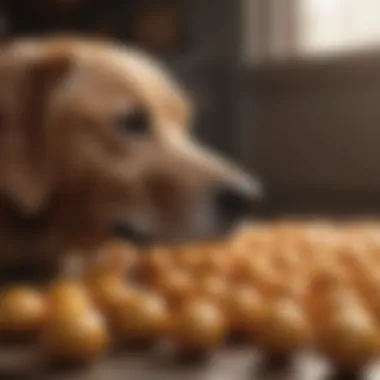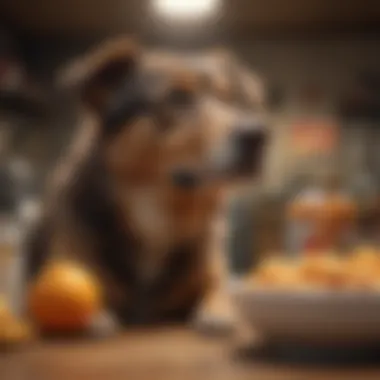Identifying Foods That Are Dangerous for Dogs


Intro
Understanding what foods are harmful to dogs is crucial for responsible pet ownership. Many pet owners, whether out of ignorance or misjudgment, may unknowingly offer their canine companions snacks that can lead to severe health complications. This article aims to clearly outline the various foods to avoid, emphasizing their dangers while promoting safe dietary practices.
Key Points
A thorough exploration of harmful foods should include various aspects
Health Risks: Discuss how specific foods can damage a dog’s system.
Common Misconceptions: Examine myths that lead to inappropriate feeding.
Symptoms of Indigestion: Recognize early warning signs of dietary distress.
Foods to Avoid
It's vital to understand why certain foods are off-limits. Below is a list of categories and examples of foods that can be dangerous for dogs:
- Chocolate: Contains theobromine, which can be toxic.
- Onions and Garlic: These can damage a dog's red blood cells.
- Grapes and Raisins: Even small quantities can lead to kidney failure.
- Avocado: Persin can cause vomiting and diarrhea.
- Xylitol: Often found in sugar-free products, this can lead to insulin release, causing hypoglycemia.
"Awareness of hazardous foods ensures a longer, healthier life for dogs."
Importance of Awareness
Dog owners play a significant role in their pets' nutrition. Awareness means being proactive about what foods to avoid. This vigilance not only prevents immediate health emergencies but also fosters a better understanding of canine needs.
Consequences of Improper Feeding
Inappropriate feeding can lead to:
- Short-term effects: Vomiting, diarrhea, and lethargy.
- Long-term effects: Chronic health issues, including diabetes and liver damage.
Solutions to Promote Safe Feeding
It is essential to adopt strategies to prevent dogs from consuming harmful foods. Here are a few actions to consider:
- Educate yourself: Familiarize with safe and unsafe foods.
- Establish boundaries: Make rules around table scraps and treats.
- Provide proper snacks: Opt for dog-specific treats that meet nutritional needs.
Epilogue
Through this guide, dog owners can gain valuable insights into foods that are not suitable for their pets. By understanding these hazards and practicing better feeding habits, they can secure the health and wellbeing of their dogs. A conscious approach to nutrition makes all the difference.
Prolusion
Understanding what foods are safe and unsafe for dogs is essential for any pet owner. Dogs, like humans, have specific dietary needs, but they also have foods that can cause serious health problems. The risk of poisoning or illness from certain foods is a critical concern for dog owners, especially considering pets may unknowingly ingest these harmful substances.
This article emphasizes the importance of knowledge concerning dog nutrition. Being informed about which foods can harm your pet can lead to better health outcomes and ultimately contribute to a longer, healthier life for your furry friend. This awareness can prevent unintended exposure to toxic foods, keeping your dog safe and happy.
There are numerous foods that may seem harmless but can have devastating results. These include common kitchen items and popular human snacks that many people might not consider dangerous. By presenting an in-depth examination of these foods, the article will guide you in recognizing hazardous ingredients and help you create a safe dietary environment for your dog.
In this article, we will delve into specific foods that are toxic to dogs. Each section will cover individual food items, their effects on dogs, and symptoms to look out for. By grasping these crucial facts, you will be in a much better position to protect your pet from potential harm. If you are a dog owner or planning to become one, understanding these dietary restrictions is not just recommended; it is vital.
The Importance of Dog Nutrition
Dog nutrition plays a crucial role in maintaining the overall health and wellbeing of our canine companions. Just like humans, dogs require a balanced diet that meets their specific nutritional needs. Proper nutrition not only influences a dog's physical health but also affects their mood, energy levels, and longevity.
One significant aspect of dog nutrition is providing appropriate food for the specific breed, size, and age of the dog. Puppies have different dietary requirements compared to adult or senior dogs. A balanced diet tailored to a dog's growth stage helps prevent developmental issues and supports healthy growth.
Proper nutrition is foundational to a pet's health. It can prevent many ailments and promote a longer, happier life for dogs.
Additionally, dogs have unique dietary needs, which can vary from one breed to another. For example, larger breeds may need specific nutrients to support joint health, while smaller breeds may require higher energy food due to their metabolism. Knowing these particular needs helps in choosing suitable foods that enhance their health.
One must also consider the quality of dog food. There are various commercial food options available in the market, but not all are suitable. Feed that contains fillers or artificial ingredients may lack essential nutrients. As such, it's vital to analyze labels and choose high-quality options that provide the necessary vitamins, minerals, and proteins.
Dietary restrictions are equally important. Some foods that seem harmless to humans can be detrimental or even toxic to dogs. Owners must educate themselves on which foods are safe and which are not. Knowing how to read ingredient lists and recognize harmful substances is part of ensuring good nutrition for dogs.


In summary, the importance of dog nutrition lies in its direct correlation with the dog's health, mood, and lifespan. Providing a balanced diet tailored to the dog's specific needs and avoiding harmful foods can significantly improve their quality of life. Regular consultations with a veterinarian can further assist in understanding the nutritional requirements for specific breeds, ensuring that our furry friends lead healthy and fulfilling lives.
Common Foods That Are Unsafe for Dogs
Chocolate
Chemical composition
Chocolate contains theobromine and caffeine, both of which are toxic to dogs. Theobromine is metabolized slowly in dogs, leading to dangerous levels accumulating in their system. The darker and richer the chocolate, the higher the theobromine content. Dark chocolate and baking chocolate pose the greatest risks. Dogs may have a hard time processing these compounds, making chocolate a particularly unsafe option.
Symptoms of chocolate toxicity
Recognizing signs of chocolate toxicity can help in seeking immediate veterinary care. Symptoms may include vomiting, diarrhea, and increased heart rate. Hyperactivity or restlessness are also common indicators of distress. Even small amounts can have adverse effects depending on the dog’s weight and the chocolate type. Taking early action can be critical in ensuring the health of a pet that has ingested chocolate.
Onions and Garlic
Allium family effects
Onions and garlic belong to the Allium family, and they contain compounds that can damage a dog's red blood cells. This leads to a condition known as hemolytic anemia, which can be extremely harmful. Both raw and cooked forms carry this risk, meaning careful consideration is needed when preparing human food.
Potential health issues
Consumption of large quantities can lead to serious health complications. Dogs may experience symptoms like weakness, lethargy, and even collapse. Ensuring that these foods are kept out of reach is essential for preventing potential emergencies. Awareness regarding the dangers of the Allium family can make a significant difference in maintaining a dog’s health.
Grapes and Raisins
Kidney failure risks
Grapes and raisins have been linked with acute kidney failure in dogs. Even small amounts can trigger serious health problems. The actual mechanism is not fully understood, but the risk is very concerning. This underscores the need for pet owners to avoid giving these fruits to their dogs.
Symptoms to watch for
Owners should be vigilant for signs such as vomiting, diarrhea, or lethargy if a dog consumes grapes or raisins. These symptoms can appear within hours of ingestion. Prompt veterinary attention is necessary to treat any potential complications. Being informed about these risks is a vital part of responsible dog ownership.
Avocado
Persin toxicity
Avocados contain a substance known as persin, which is toxic to dogs, albeit to a lesser extent compared to other foods. Persin can cause vomiting and diarrhea. Despite being a healthy fruit for humans, its consumption poses risks for dogs. It is essential to understand that some parts of the avocado, such as the pit and skin, contain higher levels of this toxin.
Affected breeds
Certain breeds may be more susceptible to the negative effects of avocado than others. Breeds like Great Danes or Shepherds may react more severely. Monitoring specific health responses in various breeds can offer insights into the impacts of avocado. Caution should always be exercised, regardless of breed when it comes to feeding pets avocado.
Alcohol
Central nervous system effects
Alcohol has a wide-ranging impact on a dog's central nervous system. Even small amounts can lead to serious health issues. Dogs may experience intoxication in much the same way humans do, but their bodies cannot process alcohol effectively. Symptoms can escalate quickly, leading to severe consequences.
Signs of alcohol poisoning
Signs of alcohol poisoning include lethargy, vomiting, and uncoordinated movements. If a dog shows these symptoms after possible alcohol exposure, immediate veterinary care is critical. The ramifications of intoxication can be fatal. Pet owners must take precautions to ensure that dogs do not have access to alcoholic beverages.
Caffeine
Sources of caffeine
Caffeine is found in various sources such as coffee, tea, and certain soft drinks. Just like chocolate, dogs metabolize caffeine poorly and can suffer severe outcomes. Guarding against caffeine consumption is crucial for health safety. This indicates the importance of keeping caffeinated products out of reach.
Health effects on dogs
The effects of caffeine on dogs can manifest as restlessness, rapid breathing, and heart palpitations. In severe cases, it can lead to seizures or even death. Vigilance regarding caffeine-containing items is an essential aspect of responsible pet ownership. Educating oneself about these risks contributes significantly to maintaining a dog's health.


Other Risky Foods to Consider
In this section, we will explore various foods that may not be as commonly known but can still pose significant health risks to dogs. Understanding these foods is crucial for dog owners who wish to maintain their pet's health. It is not always obvious what ingredients can harm our furry friends. Having awareness of these foods allows pet owners to make better dietary choices and avoid accidental poisoning.
Macadamia Nuts
Macadamia nuts are perhaps one of the lesser-known hazards in a dog’s diet. Although they may seem innocuous to humans, they can lead to serious health issues in dogs.
Symptoms of macadamia nut poisoning
When dogs consume macadamia nuts, various symptoms may arise. Commonly noted symptoms include lethargy, vomiting, and tremors. Identifying these signs early can lead to prompt veterinary care. This aspect is important because it may save a dog's life. The distinctive feature of macadamia nut poisoning is the combination of muscle tremors and gastrointestinal upset. This can be distressing for both the dog and the owner.
Severity of symptoms
The severity of symptoms can vary widely. Some dogs may exhibit mild symptoms, while others can suffer severe reactions, such as an inability to walk. Recognizing this range is significant because it influences how quickly owners should respond. Quick action can lessen the impact of symptoms. If a dog shows concerning symptoms after consumption, immediate consultation with a veterinarian is highly recommended.
Xylitol
Xylitol, a common sugar substitute, is extremely dangerous for dogs. Its use has increased in many foods, particularly sugar-free items.
Sugar substitute dangers
The dangers of xylitol lie in how it affects a dog's insulin levels. It can cause rapid drops in blood sugar, leading to hypoglycemia. This aspect is critical because xylitol is found in products pet owners may not suspect. It’s vital to read food labels closely to avoid this ingredient. Xylitol toxicity symptoms can develop suddenly, making awareness especially important for dog owners.
Hypoglycemia risks
Hypoglycemia risks present a severe health threat. Symptoms can include weakness, disorientation, and seizures. This detail highlights the importance of recognizing xylitol as a toxin. Owners need to understand that even small amounts can be harmful. If you suspect your dog has ingested xylitol, seek veterinary help immediately.
Yeast Dough
Yeast dough is another food item that risks your dog's health. While it may be a tasty treat for humans, the fermentation process can create problems.
Fermentation risks
The fermentation of yeast dough can lead to gas production in a dog’s stomach. This can cause severe bloating and pain. The potential for a dangerous condition called gastric dilatation-volvulus exists. This makes understanding the risks essential for dog owners.
Signs of distress in dogs
Signs of distress can manifest as restlessness, whining, or attempts to vomit. Being aware of these signs is key for any dog owner. Dogs in distress may need urgent medical intervention. Therefore, keeping yeast dough out of reach is a simple yet effective preventive measure.
Coconut and Coconut Oil
While some may consider coconut a healthy option, it has potential downsides for dogs.
Digestive issues
Coconut products can lead to digestive upset in dogs. Some might experience diarrhea or gastrointestinal discomfort after consumption. Understanding this risk can help owners make informed choices about what to feed their pets.
Preferred use in moderation
If you choose to include coconut in your dog’s diet, moderation is crucial. Small amounts might be safe, but large quantities can lead to complications. Therefore, it’s wise for dog owners to approach coconut with caution.
Processed Foods
Processed foods can encompass a range of items that pose hidden dangers. Awareness of this topic is critical for maintaining optimal dog health.
Nutritional deficiencies
Processed foods often lack the essential nutrients that dogs need. This can lead to deficiencies that manifest over time. Recognizing this can help dog owners provide better diets that support overall health.
Long-term health consequences
Long-term consumption of processed foods may lead to serious health problems, such as obesity and heart diseases. Pet owners should think critically about feeding these foods regularly. It is vital for the long-term wellness of dogs. Educating oneself about the risks of processed food is a step towards improving a dog's diet.


Recognizing Symptoms of Food Poisoning
Recognizing symptoms of food poisoning in dogs is crucial for their health. Dogs cannot communicate their discomfort the way humans can. Therefore, owners must be vigilant in observing any changes in behavior or physical condition. Early detection can lead to timely intervention, which may prevent serious health outcomes. Understanding how to recognize symptoms empowers dog owners to act quickly if their pets ingest harmful substances. This section unfolds critical signs to watch for and offers guidance on when to seek veterinary assistance.
Common Symptoms
Vomiting
Vomiting is a common symptom in dogs that may indicate food poisoning. It serves as a natural mechanism for the dog’s body to eliminate harmful substances. When a dog vomits, it can be a response to toxic food or an underlying health issue. A key characteristic of vomiting is its sudden onset. Observing this behavior can alert an owner to potential poisoning. However, frequent vomiting can lead to dehydration, making it a symptom of concern.
Diarrhea
Diarrhea is another notable symptom of food poisoning in dogs. This condition often occurs alongside vomiting, and it reflects the body’s effort to expel noxious substances. A significant aspect of diarrhea is its frequency, which can vary from mild to severe. Recognizing the pattern and consistency is vital. Liquid stools can lead to dehydration and nutrient loss quickly, making it critical for owners to monitor their pet's bowel habits closely.
Lethargy
Lethargy often accompanies other symptoms of food poisoning. It refers to a noticeable lack of energy or enthusiasm in a dog. A lethargic dog may refuse to play, show disinterest in food, or sleep more than usual. This symptom signals that something is wrong, possibly due to toxic food intake or dehydration. Understanding lethargy is essential in assessing the overall health of the dog. It indicates the need for further evaluation if present alongside other symptoms.
When to Seek Veterinary Help
Signs of Severe Distress
Certain signs indicate that a dog requires immediate veterinary attention. Symptoms like excessive vomiting, persistent diarrhea, and unresponsiveness can suggest severe distress. Another alarming sign is difficulty breathing, which may indicate more serious conditions. These symptoms are critical elements in assessing a dog's well-being. Noting these details allows the veterinarian to determine appropriate treatments or interventions quickly.
Emergency Protocols
Knowing emergency protocols can save a pet's life in critical situations. First, the dog should be taken to a veterinarian as soon as possible. Keeping a list of symptoms noted can help the vet make an accurate diagnosis. Moreover, having access to a pet first-aid kit is beneficial for emergencies. This kit might include items like activated charcoal, which helps absorb toxins if given in appropriate situations. Understanding these protocols is invaluable when a quick response is necessary.
"Recognizing symptoms early can be the difference between quick recovery or severe complications."
Therefore, the ability to recognize and respond to symptoms of food poisoning is an essential skill for dog owners. By closely monitoring their pets, owners can assist in maintaining a safe and healthy environment.
Safe Alternatives and Recommendations
The section on safe alternatives and recommendations is crucial in understanding how to ensure a dog's diet is not only safe but also nutritious. This area serves to steer dog owners away from harmful food choices while providing viable and healthier options. It addresses the growing need for pet owners to be aware of what they can feed their dogs without risking their health. Safe alternatives offer important benefits, including better overall nutrition and reduced risk of chronic health issues. Understanding safe choices can also foster a deeper relationship between pet owners and their dogs, as owners become more cognizant of what their pets consume.
Healthy Treat Options
Fruits and Vegetables
Fruits and vegetables provide a variety of vitamins and minerals essential for a dog’s health. They can be an excellent component of a balanced diet. The high fiber content in many fruits and vegetables aids digestion. For instance, carrots are not only crunchy and appealing but also rich in beta-carotene, an antioxidant beneficial for the eyes. Other fruits like blueberries and apples offer antioxidants and vitamins that promote immune health. However, owners should be cautious with portions, as some dogs may not digest certain fruits or vegetables well, leading to gastrointestinal upset. Therefore, it's important to introduce any new food gradually.
Commercial Dog Treats
Commercial dog treats are designed specifically for a dog's dietary needs. They often contain essential nutrients and are formulated to support various aspects of canine health. A primary characteristic of these treats is their convenience. They are available in various flavors and forms, catering to picky eaters. Additionally, many brands are using high-quality ingredients without preservatives or fillers. However, not all treats are equally made. Owners must read labels carefully and choose those with superior ingredients. It's also wise to consider the caloric content, as overindulgence can lead to weight gain.
Consulting with a Veterinarian
Personalized dietary advice
Personalized dietary advice is an important aspect of ensuring a dog's dietary health. Each dog is unique, with specific nutritional needs based on factors like breed, age, and health conditions. A veterinarian can assess these individual factors and recommend a tailored diet plan. This approach helps prevent issues like obesity and allergies that may arise from generic feeding guidelines. Working with a vet is especially beneficial if a dog has existing health concerns, providing a clear understanding of how to manage their diet effectively.
Understanding breed-specific needs
Understanding breed-specific needs is another vital area that showcases the importance of tailored dietary requirements. Different breeds may have unique dietary restrictions and preferences that owners must acknowledge. For instance, some large breeds are prone to specific issues like hip dysplasia and may benefit from diets low in calories but high in nutrients that promote joint health. Knowing a dog's breed can guide owners in selecting the right food options and prevent potential health problems. This detailed understanding empowers owners to care effectively for their pets, leading to a healthier lifestyle for their dogs.
The End
Understanding the importance of what foods are not suitable for dogs is essential for every dog owner. The health and wellbeing of a pet depend significantly on their diet. This final section highlights the key takeaways discussed throughout the article, emphasizing the crucial points to remember.
First and foremost, dog owners need to be aware of the specific foods that can be harmful to their animals. Chocolate, grapes, and onions are just a few examples among many. Each of these foods poses distinct health risks that can range from mild discomfort to severe illness. Recognizing these dangers is the first step in preventing accidental ingestion.
Secondly, being knowledgeable about the symptoms of food poisoning can make a difference in a dog’s recovery. Common symptoms like vomiting and lethargy signal that something is wrong. If these symptoms occur after the dog consumes a questionable food, it is vital to consult a veterinarian as soon as possible.
Additionally, offering safe alternatives, such as fruits and commercial dog treats, ensures that your pet can enjoy nutritious snacks without the associated risks. This not only safeguards their health but also contributes to a better quality of life, as dogs thrive on a balanced diet.
Lastly, consulting with a veterinarian can provide tailored dietary advice. A professional can help you understand your dog's specific nutritional needs based on breed, age, and health status, ensuring you give them the best care possible.
"Prevention is always better than cure. Knowing what foods are harmful protects our furry friends and keeps them healthy."







